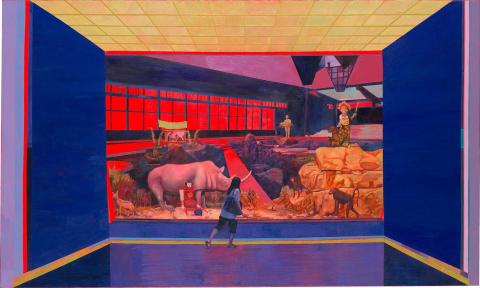2018.235 ALBAIQUNI
By Reuben Keehan
February 2020
Zico Albaiquni’s canvases are rich with references and juxtapositions. He examines Indonesian painting traditions and broader art histories, with a particular interest in how the Indonesian landscape has been treated and commodified throughout history. Underpinning these investigations is the Indonesian concept of lukisan (roughly translating as ‘painting’) and its ethnic purpose, tied as it is to ritual, exchange, and the creation of sacred objects. Albaiquni’s distinct palette arises from pigment combinations drawn from the colonial painting genre of Mooi Indie (‘beautiful Indies’).
The scattered motifs in this work relate to Indonesian artists who participated in the first three Asia Pacific Triennial (APT) exhibitions at the Gallery, including Heri Dono, Arahmaiani and Albaiquni’s father Tisna Sanjaya. The blue room with gold roof, and the work’s title, reference artist AD Pirous’s Bila Bumi Bergetar II (When Earth Quakes II) 1991 — a painting that featured in the very first APT in 1993.
Connected objects
Metadata, copyright and sharing information
About this story
- Subject
